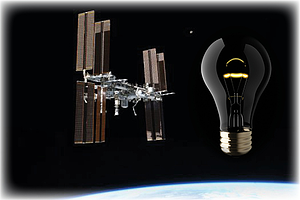 If you’re really hoping for an answer to that question, we’re sorry to say that we’re going to have to disappoint you. At this point in time, not even NASA knows how many scientists it takes to change a light bulb in the International Space Station—but they’re working on it. Really!
If you’re really hoping for an answer to that question, we’re sorry to say that we’re going to have to disappoint you. At this point in time, not even NASA knows how many scientists it takes to change a light bulb in the International Space Station—but they’re working on it. Really!
As it turns out, lighting is a really big deal—even out in space. And there is increasing evidence that the kind of lighting astronauts are exposed to is affecting their sleeping patterns. For a group known as insomniacs in the first place, that’s not good news.
Actually, being able to track an astronaut’s fatigue problems to potential lighting issues is a good thing. That’s why NASA plans to swap out 85 fluorescent lights on the U.S. portion of the orbital lab and replace them with special diffused LEDs, which can filter light into different hues. They would provide white light during work hours, bluish light in the morning or when it’s important that astronauts wake up for an emergency, and reddish light to help them sleep. Whether changing out the bulbs will solve the problem remains to be seen. But NASA isn’t the only organization focusing on changing light bulbs.
Researchers at Wake Forest University have developed a field-induced polymer elecroluminescent (FIPEL) lighting technology that silently gives off a soft, white glow, without the annoying hum and yellow tint of fluorescent bulbs or the sharp, bluish hue of LED light fixtures.
While FIPEL isn’t brand new technology, it hasn’t really emerged as a viable light source, yet. But keep your eyes open, because this technology is twice as efficient as CFL technology—without the hazardous materials those bulbs contain. It’s more akin to the efficiency of LED technology. But it has an advantage: it can be adjusted (in manufacturing) to give off the softer, white light that people prefer. There are some rumors that FIPEL lighting could be on the market sometime this year.
What does that mean for you? Should you be recommending this technology to your customers? It’s probably a bit early for that. But the fact is that light affects the way we live and work. And there are lots of commercial buildings that still use old fluorescent bulbs that have a negative impact on worker comfort—and productivity. If you’ve got commercial clients who are still on the fluorescent bandwagon, shoot me a note for some ideas about solutions that can help them out.
We may not know how many NASA scientists it takes to change a light bulb. But at least we understand why they’re trying it!
